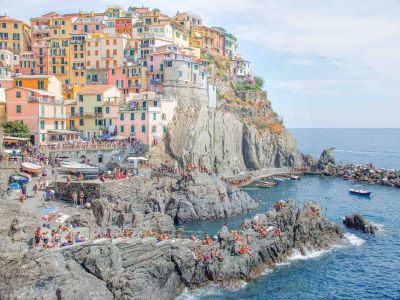The Italian Riviera sets the scene for a murder mystery, with Deputy Assistant Chief of Police Luigi Berté, recently transferred from Milan to the coastal town of Lungariva, taking the lead in the investigation. Easter Monday is the traditional start of preparations for the tourist season, but the double murder discovered that morning dominates the town, police, and press, and brings a slew of suspects.
The story begins with Berté contemplating his life, interrupted by a call to the historic Grand Hotel Miramare where two bodies have been found in one of the hotel’s guest rooms. After meeting the manager who is “shocked…nothing has ever happened like this before,” Berté learns the victims are “two permanent guests…the accountant and the secretary of Countess Van Der Meer,” one of the hotel’s “most important clients.”
Soon after “a sudden, intense fragrance made him turn,” and the countess “about seventy-five, tall, blond – impeccably blond – thin and elegant” is standing in the doorway. When he later asks the countess if she knew about a relationship between her accountant and her secretary, she replies, “I would have dismissed both of them. I do not tolerate illicit affairs.”
Along with the disruption of a three-day holiday weekend and the constant movements of hotel guests, the victims’ families are brought in for questioning. The investigation takes four days and elicits a colorful collection of characters as the intricate descriptions of their appearances and personality traits add to the subplot. While hotel guests and staff and family members are being interviewed, numerous suspects are scrutinized for their actions and motives, and new ones are added to the list.
Laced throughout the investigation are Berté’s inner thoughts about his and others’ comments during conversations and contemplations of his affair with the owner of a local pensione. When the local paper’s four-page spread about the murder features a picture of Berté with a female detective, he wonders what his lover’s reaction will be. Unsettled, that morning at breakfast he takes notice of the small vase of flowers on his table, different from those on the other tables, and questions her selection. “They’re winter calycanthus. It wasn’t easy to find them…they remind me of you. These little flowers are resistant to pests. They’re simple and sincere, and yet have a very sensual fragrance.”
With “No footprints or DNA, no eyewitnesses…and plenty of suspects” Berté is concerned the investigation is heading into dangerous territory and he digs further into the past of several hotel guests. Surprising new evidence brings a twist to the investigation and pursuit of the main suspect, who has fled from the hotel.
Sisters Elena and Michela Martignoni have crafted a story of suspense using the real Grand Hotel Miramare on the Ligurian Coast in the town of Santa Margherita Ligure as the framework for the novel. Beyond the suspense, Berté’s fondness for Italian food provides the reader with impressive descriptions of the meals served, numerous mentions of limoncello and chocolate Easter eggs, as well as a Ligurian specialty, focaccia. “A waiter brought in a pyramid of focaccia, a mix of plain focaccia and focaccia with olives and onions, that momentarily distracted Berté.” On a walk through town, Berté stops at a popular bakery where “the employees were cutting and serving the bakery’s specialty, focaccia…Proper focaccia is a Ligurian delicacy. Each bakery has its own house style and true connoisseurs appreciate their subtle differences.”
Insights of Italian culture and history are scattered throughout the story. Most notably: “along the boardwalk…a statue of Christopher Columbus, his arms stretched out toward America. Columbus was a distinguished Ligurian, at least as far as Italians are concerned…Perhaps the world’s greatest explorer was good for tourism. ‘The Americans stole the telephone. The Germans stole blue jeans. Now they won’t even leave us Columbus!’ thought Berté…”
Adding to the story line is the wit of the Martignoni sisters. Several instances provide humor and the scene at the police station, that Berté titles “three men and a dog,” is an episode worthy of an on-stage comic.
Berté is a recurring character in the Martignoni sisters’ books, and the first to be translated into English through Kazabo Publishing. Berté also dabbles in writing and recalls a conversation with a bookseller about a book “with a long list of suspects and a very well-crafted plot…written by Augusto De Angelis…He’s considered the father of Italian crime novels…”
That book, “Death in a Bookstore” is also available in English through Kazabo Publishing, and the prologue has been included in “Double Murder at the Grand Hotel Miramare.”
https://www.lagazzettaitaliana.com/history-culture/10341-from-the-italian-american-press-double-murder-at-the-grand-hotel-miramare#sigProIdacb94f3d84




